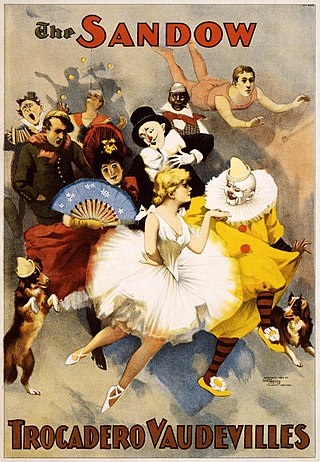
Vaudeville is a theatrical genre of variety entertainment which began in France at the end of the 19th century. A vaudeville was originally a comedy without psychological or moral intentions, based on a comical situation: a dramatic composition or light poetry, interspersed with songs or ballets. It became popular in the United States and Canada from the early 1880s until the early 1930s, while changing over time.
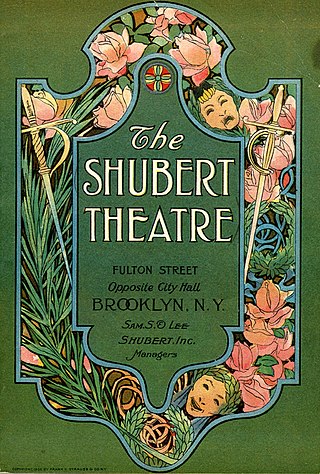
The Shubert Organization is a theatrical producing organization and a major owner of theatres based in Manhattan, New York City. It was founded by the three Shubert brothers — Lee, Sam, and Jacob J. Shubert — in the late 19th century. They steadily expanded, owning many theaters in New York and across the United States. Since then it has gone through changes of ownership, but it is still a major theater chain.

The Palace Theatre is a Broadway theater at 1564 Broadway, facing Times Square, in the Midtown Manhattan neighborhood of New York City. Designed by Milwaukee architects Kirchhoff & Rose, the theater was funded by Martin Beck and opened in 1913. From its opening to about 1929, the Palace was considered among vaudeville performers as the flagship venue of Benjamin Franklin Keith and Edward Franklin Albee II's organization. The theater had 1,648 seats across three levels as of 2018.
Theatre Owners Booking Association, or T.O.B.A., was the vaudeville circuit for African American performers in the 1920s. The theaters mostly had white owners, though about a third of them had Black owners, including the recently restored Morton Theater in Athens, Georgia, originally operated by "Pinky" Monroe Morton, and Douglass Theatre in Macon, Georgia owned and operated by Charles Henry Douglass. Theater owners booked jazz and blues musicians and singers, comedians, and other performers, including the classically trained, such as operatic soprano Sissieretta Jones, known as "The Black Patti", for black audiences.
Harry Steppe, March 16, 1888 – November 22, 1934 was a Russian Jewish-American actor, musical comedy performer, headliner comedian, writer, librettist, director and producer, who toured North America working in Vaudeville and Burlesque. Steppe performed at several well-known theaters on the Columbia, Mutual and Orpheum circuits. Steppe was one of Bud Abbott's first partners.

The Broadway Theater District in the Historic Core of Downtown Los Angeles is the first and largest historic theater district listed on the National Register of Historic Places (NRHP). With twelve movie palaces located along a six-block stretch of Broadway, it is the only large concentration of movie palaces left in the United States. The same six-block stretch of Broadway, and an adjacent section of Seventh Street, was also the city's retail hub for the first half of the twentieth century, lined with large and small department stores and specialty stores.
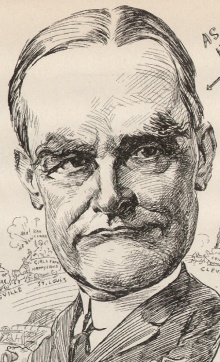
Sam A. Scribner was an American circus and burlesque impresario of the late nineteenth and early twentieth centuries. He operated the Columbia Amusement Company, presenting forty or more family-entertainment burlesque shows simultaneously in theaters throughout the Northeast and Midwest of the United States.

The Harlem Alhambra was a theater in Harlem, New York, built in 1905, that began as a vaudeville venue. The building still stands at 2108-2118 Adam Clayton Powell Jr. Boulevard at the South-West corner of 126th Street. The architect was John Bailey McElfatrick (1829–1906) who, based in Manhattan, founded the architectural firm John B. McElfatrick & Son – builder of 100 theaters. Construction on the structure commenced late 1902 by its original owner, Harlem Auditorium Amusement Company.
L. Lawrence Weber was an American sports promoter, stage show producer and theater manager. He was active in arranging vaudeville shows, legitimate theater and films. He once tried to bypass laws against importing a boxing film to the US by projecting it on a screen just across the border in Canada and filming the screening from the USA side.
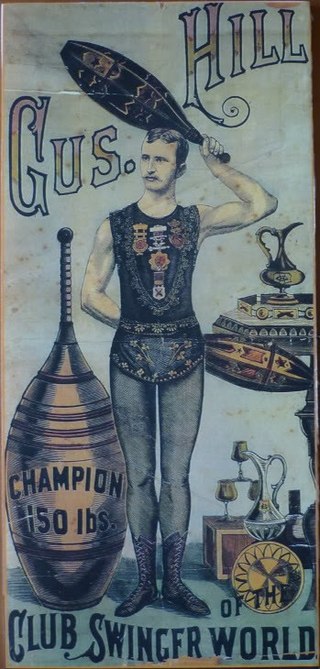
Gus Hill was an American vaudeville performer who juggled Indian clubs. He later became a burlesque and vaudeville entrepreneur. Hill was one of the founders of the Columbia Amusement Company, an association of burlesque shows and theaters, and became president of the American Burlesque Association. He also staged drama and musical comedies. He launched a highly popular series of "cartoon theatricals", musical comedies based on comic strips or cartoons. At one time he was running fourteen different shows.

The Columbia Amusement Company, also called the Columbia Wheel or the Eastern Burlesque Wheel, was a show business organization that produced burlesque shows in the United States between 1902 and 1927. Each year, between three and four dozen Columbia burlesque companies would travel in succession round a "wheel" of theaters, ensuring steady employment for performers and a steady supply of new shows for participating theaters. For much of its history the Columbia Wheel promoted relatively "clean" variety shows featuring comedians and pretty girls. Eventually the wheel was forced out of business due to changing tastes and competition from its one-time subsidiary and eventual rival, the Mutual Burlesque Association, as well as cinemas and cruder stock burlesque companies.

William H. McElfatrick was an American architect who specialized in theaters.
The Vaudeville Managers Association (VMA) was a cartel of managers of American vaudeville theaters established in 1900, dominated by the Boston-based Keith-Albee chain. Soon afterwards the Western Vaudeville Managers Association (WVMA) was formed as a cartel of theater owners in Chicago and the west, dominated by the Orpheum Circuit. Although rivals, the two organizations collaborated in booking acts and dealing with the performers' union, the White Rats. By 1913 Edward Franklin Albee II had effective control over both the VMA and WVMA. In the 1920s vaudeville went into decline, unable to compete with film. In 1927 the Keith-Albee and Orpheum chains merged. The next year they became part of RKO Pictures.
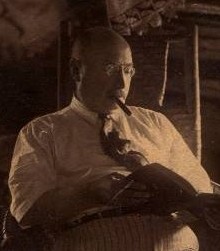
Percy Garnett Williams was an American actor who became a travelling medicine salesman, real estate investor, amusement park operator and vaudeville theater owner and manager. He ran the Greater New York Circuit of first-class venues. Williams was known for giving generous pay and good working conditions to performers. At his death, he endowed his Long Island house as a retirement home for aged and destitute actors.
William Hammerstein was an American theater manager. He ran the Victoria Theatre on what became Times Square, Manhattan, presenting very popular vaudeville shows with a wide variety of acts. He was known for "freak acts", where celebrities or people notorious for scandals appeared on stage. Hammerstein's Victoria Theatre became the most successful in New York.
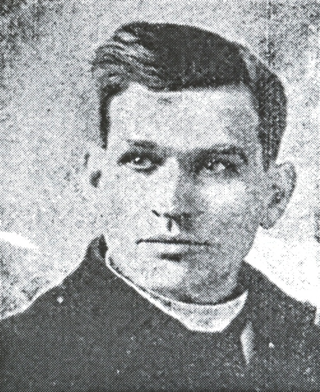
Sam T. Jack, a burlesque impresario, was a pioneer of the African-American vaudeville industry in the US with his Creole Burlesque Show. He was also known for staging increasingly risqué shows in Chicago, where young women appeared wearing only skin-colored tights.
Isidore H. Herk was a burlesque manager who played a major role in the evolution of this entertainment before World War II. His show at the Gaiety Theatre, closed in 1941, was the last burlesque show on Broadway.
The Six Rockets was a German, all-girl, acrobat troupe that enjoyed a run of success touring variety circuits, largely in the United States, ostensibly between 1905 and 1933. When not on the road, the troupe was managed out of Leipzig by local impresario Oswald Büttner.

The Shore Theater is a former movie theater in the Coney Island neighborhood of Brooklyn in New York City. The seven-story neo-Renaissance Revival building, with office space as well as a theater, is located at the intersection of Surf and Stillwell Avenues, across from Nathan's Famous and the Coney Island–Stillwell Avenue station. Completed in 1925, it was one of several structures that was intended to boost the development of Coney Island as a year-round entertainment destination. After being abandoned in the 1970s, it stood unused for several years before being redeveloped into a hotel in the late 2010s. As of 2023, the building is still undergoing reconstruction.

The Mutual Burlesque Association, also called the Mutual Wheel or the MBA, was an American burlesque circuit active from 1922 until 1931. Controlled by Isidore Herk, it quickly replaced its parent company and competitor, the Columbia Amusement Company, as the preeminent burlesque circuit during the Roaring Twenties. Comedians Bud Abbott, Lou Costello, Harry Steppe, Joe Penner, Billy Gilbert, Rags Ragland, and Billy Hagan, as well as stripteasers Ann Corio, Hinda Wausau, Gypsy Rose Lee, and Carrie Finnell, performed in Mutual shows. Mae West appeared in Mutual shows from 1922 to 1925. Mutual collapsed during the Great Depression.
















